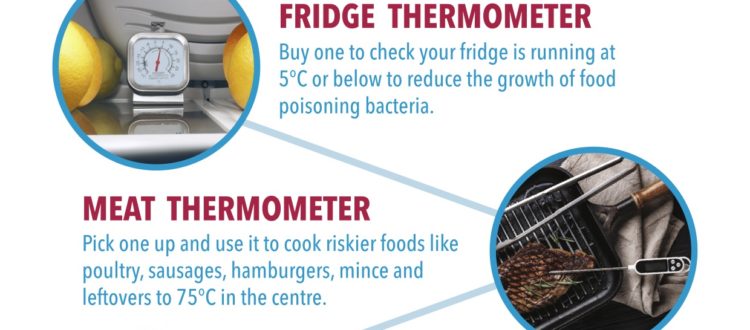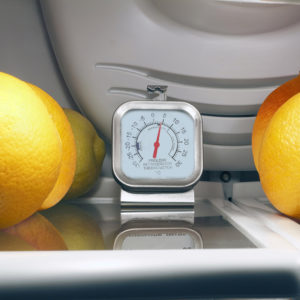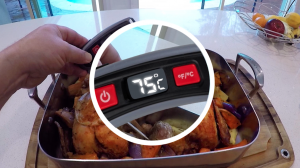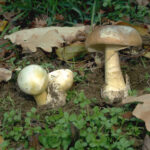
You can greatly reduce your risk of becoming one of the estimated 4.76 million cases of food poisoning each year with this simple food safety toolbox
Get a fridge thermometer
 To check if your fridge is operating at the correct temperature you need to purchase a thermometer from your local homeware store and place it in the fridge. When you do this you might get some surprises. The temperature inside your fridge will vary several degrees as the fridge goes through its cycle. It will also vary markedly from one section to another.
To check if your fridge is operating at the correct temperature you need to purchase a thermometer from your local homeware store and place it in the fridge. When you do this you might get some surprises. The temperature inside your fridge will vary several degrees as the fridge goes through its cycle. It will also vary markedly from one section to another.
The door is usually the warmest part and the top shelf is often the warmest shelf. We suggest you place your thermometer below the top shelf and towards the door where you can read it easily to give a general indication of the fridge temperature.
If the thermometer shows your fridge is higher than five degrees, adjust the fridge setting to lower the temperature. The crispers for fruit and vegetables will usually be slightly warmer so that the fruit and vegetables don’t freeze. You might have to adjust the fridge a few times to get it right, but ideally, you want the main compartment to spend most of its time around 4 to 5°C. Check that food looks and feels frozen to be sure your freezer is functioning correctly or use a thermometer if you have one covering this range. Partially frozen food will have a shorter shelf life. Find out more
Get a meat thermometer
 Whole pieces of meat, such as steak, beef, pork and lamb, can be cooked to taste (rare, medium-rare and well done) as long as the outside of the meat is fully cooked to kill external bacteria. Meats that are mechanically tenderized, marinated and moisture enhanced are an exception as bacteria can be introduced into the meat during the processing and they should be treated as stuffed, rolled or minced meats.
Whole pieces of meat, such as steak, beef, pork and lamb, can be cooked to taste (rare, medium-rare and well done) as long as the outside of the meat is fully cooked to kill external bacteria. Meats that are mechanically tenderized, marinated and moisture enhanced are an exception as bacteria can be introduced into the meat during the processing and they should be treated as stuffed, rolled or minced meats.
Always cook chicken, rolled and stuffed meats, tenderized, marinated and moisture enhanced meats, sausages and minced meat, such as hamburger patties and sausages, so that in the centre of the thickest part the temperature reaches 75°C. This is because food poisoning bacteria can be present all the way through these types of meat products as well as on the surface and only thorough cooking will kill them. See more details on safe cooking temperatures.
To check whether these foods have been sufficiently cooked to 75°C you need to use a meat thermometer.
Meat thermometers are available from good kitchen shops and some electrical stores ranging in price from between $12 to $40 or more. In the upper price range, digital thermometers can be easier to read and those with fine sensitive tips can be more accurate. Using a thermometer to test when food is cooked not only ensures safe food, it also avoids guessing and ensures you cook your food to perfection every time.
To test the temperature the thermometer probe should be inserted in the thickest part of the meat, such as the thigh on poultry, not touching bone or gristle which can give a false reading. Poultry, sausages, hamburgers, tenderized, marinated and moisture enhanced meats and rolled roast meat should reach an internal temperature of 75°C to ensure all food poisoning bacteria are killed. Find out more
Take a food safety course
 Whether you want to set up your own food business, help out at the school canteen or just to keep food safe at home take a simple food safety course to learn more. We have partnered with our member First for Training who has simple on-line training courses find out more
Whether you want to set up your own food business, help out at the school canteen or just to keep food safe at home take a simple food safety course to learn more. We have partnered with our member First for Training who has simple on-line training courses find out more
Be prepared for emergencies
 Power can go out for many reasons whether it is planned maintenance or severe weather, fires or floods. Learn what to do with the food in your fridge or freezer before the power goes out and what essential items you need. Find out more
Power can go out for many reasons whether it is planned maintenance or severe weather, fires or floods. Learn what to do with the food in your fridge or freezer before the power goes out and what essential items you need. Find out more



